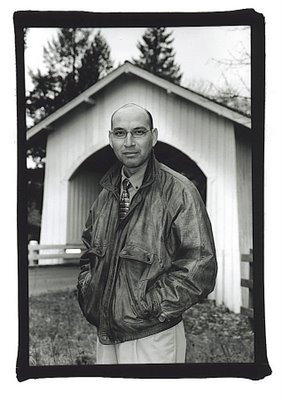Solar Power
A fairly major tool of art photography in the 1930's, it's widely believed this process was discovered accidentally -- an unwitting photog flicks the overhead white light switch on midway through the darkroom printing process and the rest is history. Black and white solarization prints are characterized by the Sabatier Effect (named for its inventor) -- an overall darkened look with distinctive black shadow-like lines around subjects while bright images display a fuzzy, crystal-like white glow. Due to variations in light source intensity and timing plus strength of developing fluid, no two solarizations are exactly alike. To take the technique a step further, a Posterization uses a solarization print as a negative and produces a super-high contrast image, such as the second and third panels of this triptych of former NBA star Dennis Rodman.
Here's how those posterizations were made: starting with a flipped negative in the carrier (you're making a negative so the image needs to be printed backwards), expose the paper normally but process it in nearly-exhausted Dektol developer. Midway through the process, quickly turn the overhead white lights on for a few seconds to overexpose the print, then turn the lights back off and complete the development process as usual. Take the dried solarization print and lay it face down on the emulsion side of another sheet of paper, place them under a sheet of glass and make an extra-long exposure (experimentation is required!) and then process this "new" print normally.
Black and white solarization and posterization prints can transform an ordinary portrait into an expressive statement. You'll spend some time and burn some paper, but it's a great way to get you back in the darkroom and exercise your creative impulses. Of course, all this can be done with a couple of mouse clicks now, but in the recent past, photographic solarizations really were Solar Powered!



0 Comments:
Post a Comment
<< Home